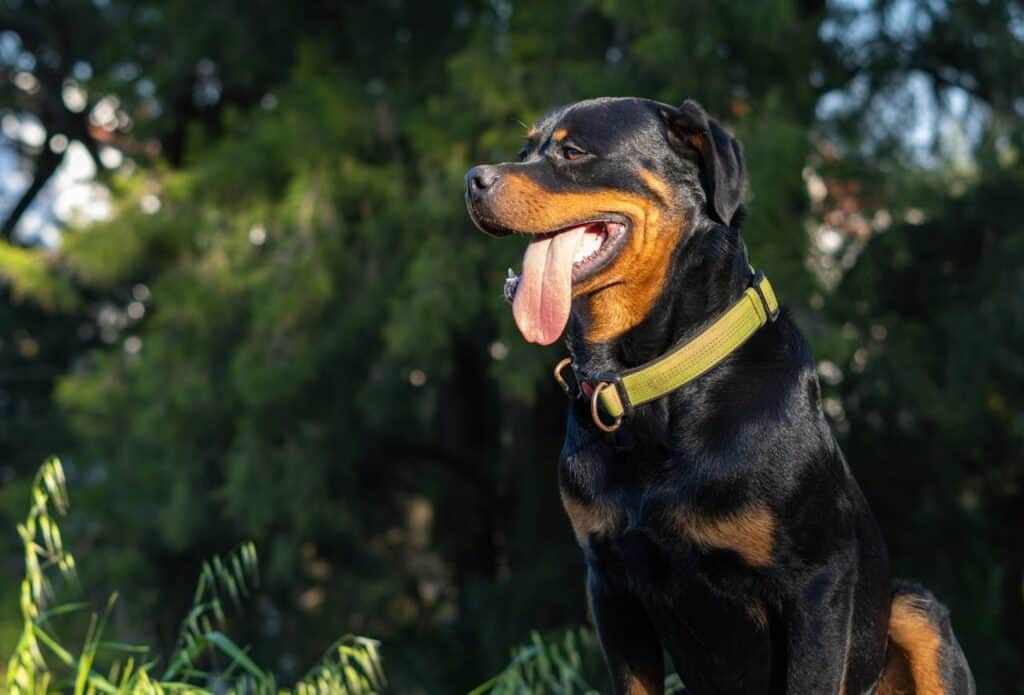1. Introduction
Brief Overview of the Rottweiler
The Rottweiler, known for its strength, loyalty, and protective nature, is a breed with a rich history and a distinctive appearance. Originally bred in Germany, Rottweilers were utilized for herding livestock and pulling carts laden with butchered meat to market. Today, they are renowned not only as formidable working dogs but also as loyal family companions. Their robust physique and alert demeanor make them excellent guard dogs, while their intelligence and trainability enable them to excel in various roles, including police work, search and rescue, and service assistance.
Key Characteristics and Traits
Rottweilers are medium to large-sized dogs, with a powerful and athletic build. They possess a short, dense coat that is predominantly black with clearly defined rust-colored markings. Known for their confident and calm temperament, Rottweilers are highly trainable and eager to work. Their natural guarding instincts, coupled with their loyalty and affectionate nature towards their family, make them exceptional protectors and companions.
2. Deep Scientific Insights of the Rottweiler
Cognitive Abilities and Intelligence
Rottweilers are known for their impressive cognitive abilities and high intelligence. According to research by Stanley Coren, Rottweilers rank among the top 10 most intelligent dog breeds. They are capable of learning new commands quickly, often within a few repetitions, and exhibit a high level of obedience. This intelligence makes them highly adaptable and proficient in various tasks, from herding to advanced obedience training and protection work.
Detection Skills and Olfactory Research
Although not as commonly used in detection roles as some other breeds, Rottweilers possess a keen sense of smell. Studies, such as those conducted by the University of Pennsylvania’s Working Dog Center, have explored the olfactory capabilities of Rottweilers and other breeds. Rottweilers have been trained successfully in scent detection for drugs, explosives, and search and rescue operations. Their strong work ethic and focus make them reliable candidates for such roles, though their primary use has traditionally been in protection and guarding.
Behavioral Genetics and Temperament
The temperament of Rottweilers is influenced by both genetics and their upbringing. Research into canine behavioral genetics has identified specific genes associated with traits such as aggression, sociability, and trainability. A study published in the journal Frontiers in Psychology highlighted the heritable nature of certain behavioral traits in Rottweilers, indicating that responsible breeding practices are crucial for maintaining the breed’s desired characteristics. Understanding these genetic influences helps breeders and owners cultivate the Rottweiler’s natural protective instincts while ensuring a balanced and well-socialized temperament.
Role in Medical Therapy and Assistance
Rottweilers have been successfully employed in various medical and therapeutic roles. Studies from institutions such as the Mayo Clinic have shown that therapy dogs, including Rottweilers, can provide significant emotional and psychological benefits to patients. Their calm and confident demeanor, combined with their loyalty and affection, make them effective therapy dogs for individuals dealing with anxiety, PTSD, and other conditions. Additionally, Rottweilers have been trained as service dogs, assisting individuals with disabilities by performing tasks that enhance their quality of life.
3. History and Origin
Origin of the Rottweiler
The Rottweiler’s origins date back to the Roman Empire, where they were used as drover dogs to herd cattle and protect the camps. As the Romans traveled across Europe, these dogs bred with local dogs, giving rise to the Rottweiler. The breed got its name from the German town of Rottweil, where they were used to drive cattle to market and pull carts for butchers. This historical role earned them the nickname “Rottweil butchers’ dogs.” The breed’s versatility and strength made them indispensable in their early roles.
Historical Roles and Significance
Historically, Rottweilers were valued for their ability to work tirelessly, herding livestock and protecting their owners’ property. Their role as draft dogs, pulling heavy carts, showcased their strength and endurance. During the late 19th century, with the advent of motorized transport, the need for their herding and cart-pulling skills diminished. However, their versatility allowed them to transition into roles in law enforcement, search and rescue, and as loyal family companions. Today, Rottweilers continue to be celebrated for their working capabilities and their steadfast loyalty.

4. Physical Characteristics
Size and Weight of the Rottweiler
Rottweilers are robust, medium to large-sized dogs. Males typically stand between 24 to 27 inches tall at the shoulder and weigh between 95 to 135 pounds. Females are slightly smaller, standing between 22 to 25 inches tall and weighing between 80 to 100 pounds. Their strong and muscular build contributes to their reputation as powerful and capable working dogs.
Coat Type and Color
The Rottweiler’s coat is short, dense, and straight, providing excellent protection against the elements. The coat is predominantly black with well-defined rust-colored markings on the cheeks, muzzle, chest, legs, and under the tail. This distinctive coloration adds to their striking and formidable appearance. Despite their short coat, Rottweilers do shed, and regular grooming helps to manage this.
Distinctive Features
Rottweilers are known for their strong, broad heads and powerful jaws. Their dark, almond-shaped eyes convey a calm and confident expression. Erect ears that fold forward when alert and a strong, muscular neck are also characteristic features. Their overall appearance is one of strength, agility, and endurance, making them instantly recognizable and respected.
5. Temperament and Personality
General Behavior and Traits of the Rottweiler
Rottweilers are known for their confident, calm, and loyal nature. They are naturally protective and make excellent guard dogs, but they are also affectionate and playful with their families. Proper training and socialization are crucial to ensure their protective instincts are directed appropriately. Rottweilers are intelligent and eager to work, often excelling in obedience training and various canine sports.
Interaction with Family, Children, and Other Pets
Rottweilers can be wonderful family pets, forming strong bonds with their owners and being particularly gentle with children. However, due to their size and strength, they should always be supervised around young children to prevent accidental injuries. With proper socialization, Rottweilers can get along well with other pets, though their natural guarding instincts may require careful introductions and management, especially with unfamiliar animals.
6. Health and Common Diseases
Typical Lifespan of the Rottweiler
The typical lifespan of a Rottweiler is around 8 to 10 years, though some can live longer with proper care and a healthy lifestyle. Regular veterinary check-ups, a balanced diet, and appropriate exercise are essential to ensure their health and longevity.
Common Health Issues and Genetic Conditions
Rottweilers are prone to several health issues, some of which are hereditary. Common problems include hip and elbow dysplasia, which are malformations of the joints that can lead to arthritis and pain. They are also susceptible to heart conditions such as subaortic stenosis (SAS) and certain types of cancer. Another concern is osteosarcoma, a form of bone cancer. Regular health screenings, responsible breeding practices, and early detection can help manage these risks and maintain the breed’s health.
7. Care and Grooming
Grooming Needs of the Rottweiler
Rottweilers have relatively low grooming needs compared to some other breeds. Their short coat requires regular brushing to remove loose hair and maintain a healthy shine. They shed moderately throughout the year, with increased shedding during seasonal changes. Regular baths, nail trimming, and ear cleaning are important to keep them clean and comfortable. Checking their teeth and providing dental care is also crucial to prevent dental diseases.
Exercise Requirements
Rottweilers are an active and energetic breed that requires ample exercise to maintain their physical and mental health. Daily walks, play sessions, and opportunities for more strenuous activities like running, hiking, or agility training are ideal. They thrive on mental stimulation and enjoy tasks that challenge their intelligence, such as obedience training, tracking, and protection work. Without sufficient exercise, they can become bored and develop behavioral problems.
8. Hypoallergenic Status
Whether the Rottweiler is Hypoallergenic
Rottweilers are not considered hypoallergenic. They shed throughout the year and produce dander, which can trigger allergies in sensitive individuals. Regular grooming and maintaining a clean living environment can help manage allergens, but they may not be the best choice for people with severe allergies.

9. Nutrition Requirements
Dietary Needs of the Rottweiler
Rottweilers require a balanced diet to maintain their health and energy levels. High-quality commercial dog food that meets their nutritional needs is generally recommended. It is important to monitor their weight and adjust portions as needed to prevent obesity, which can exacerbate joint problems and other health issues. A diet rich in protein, healthy fats, and a balance of carbohydrates, vitamins, and minerals is essential.
Recommended Food and Supplements
For Rottweilers, a diet that includes lean meats, fish, vegetables, and whole grains is recommended. Supplements such as glucosamine and chondroitin can help support joint health, particularly in older dogs or those with a predisposition to joint issues. Omega-3 fatty acids, found in fish oil, can promote a healthy coat and skin. Always consult with a veterinarian before adding supplements to your dog’s diet to ensure they are appropriate for their specific needs.
10. Ideal Owners and Families
Type of Owners Best Suited for the Rottweiler
Rottweilers are best suited for experienced owners who can provide them with the exercise, training, and socialization they need. They require a significant time commitment and thrive in homes where they can be part of the family and participate in various activities.
Owners who enjoy outdoor activities such as hiking, running, and obedience training will find Rottweilers to be enthusiastic and capable companions.
Compatibility with Families, Singles, Seniors, etc.
Rottweilers can adapt well to various living situations as long as their physical and mental needs are met. They are excellent family dogs, known for their protective and loyal nature. Singles and seniors who lead active lifestyles and can provide the necessary exercise and companionship will also find them to be devoted pets. They do best in homes with a yard or access to open spaces where they can run and play.
11. Summary
Summary of Key Points
The Rottweiler is a versatile, intelligent, and loyal breed known for its working abilities and protective nature. They require regular grooming and ample exercise to stay healthy and happy. Rottweilers are not hypoallergenic and need a balanced diet to prevent health issues. They are well-suited for experienced and active owners who can provide the attention and activity they thrive on. Despite some common health issues, regular veterinary care and a healthy lifestyle can ensure a long, fulfilling life for these dedicated and hardworking dogs.
Final Thoughts on the Rottweiler
Rottweilers are one of the most respected dog breeds for good reason. Their intelligence, loyalty, and versatility make them exceptional companions for a wide range of households. Whether as a working dog or a family pet, the Rottweiler’s courage, confidence, and unwavering devotion make them a cherished addition to any home. With proper care, training, and socialization, they can be loving and loyal companions for many years.

